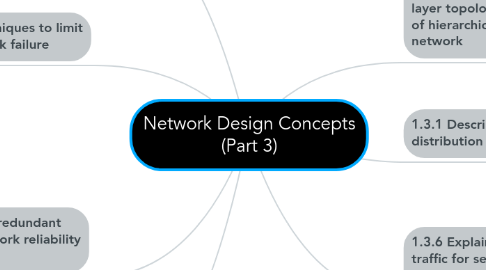Network Design Concepts (Part 3)
by Grim. Reaper

1. 1.3 Design the distribution layer topology of hierarchical network
1.1. A hierarchical network model is a useful high-level tool for designing a reliable network infrastructure
1.2. It breaks the complex problem of network design into smaller and more manageable areas
2. 1.3.1 Describe the functions of distribution layer
2.1. The distribution layer is located between the access and core layers and helps differentiate the core from the rest of the network
2.2. The purpose of this layer is to provide boundary definition using access lists and other filters to limit what gets into the core
3. 1.3.2 Describe distribution layer topology
3.1. Provides policy-based connectivity and controls the boundary between the access and core layers
4. 1.3.4 Describe techniques to limit the scope of network failure
4.1. Hardware failures
4.2. Any device can fail; make sure you perform maintenance and apply patches as needed to keep devices up to date and reduce the risk.
4.3. Security breaches
4.4. Security failures and allowing unauthorized traffic can bring down a network due to excess load
5. 1.3.5 Explain how redundant links improve network reliability and stability.
5.1. The redundant backup of the links can bring robustness, stability and reliability to the network.
5.2. the backup link also causes loops in the network. The loop problem is the most serious problem faced by the backup link
5.3. he loop between the switches will cause new network problems: broadcast storm, loops and duplicate frames
6. 1.3.6 Explain how ACLs filter traffic for security and traffic management
6.1. ACLs work on a set of rules that define how to forward or block a packet at the router’s interface.
6.2. An ACL is the same as a Stateless Firewall, which only restricts, blocks, or allows the packets that are flowing from source to destination
7. 1.3.7 Explain the routing protocol at the Distribution Layer
7.1. The distribution layer performs two-way route redistribution to exchange the routes between the RIPv2 and EIGRP
7.2. Route filtering is configured on the interfaces toward the access layer


